Tuesday, 21 May 2013
Nigeria military shells fighters' camps
|
|

The military announced a 'massive' deployment of troops to the violence-wracked northeast in late April [AFP]
|
|
A security official in northeast Nigeria says
soldiers have shelled suspected camps of armed groups in the region,
killing at least 21 people. The official said on Friday that the fighting happened on Thursday in the Sambisa Forest Reserve, just south of Maiduguri, the capital of Borno state. The official said that soldiers would remain in the area to secure it. The official also said that Nigeria's government shut off mobile phone service to parts of northeast Nigeria as soldiers moved in to enforce an emergency declaration by President Goodluck Jonathan over three states there. Phone service was restored on Friday, but the official said the phones likely would be shut off again. The official spoke on condition of anonymity as he was not authorised to speak publicly about the operation |
Nigeria to free Boko Haram members
Nigeria eases curfew in northeast
 |
|
Nigeria has relaxed a curfew in parts of the
northeast where its troops are mounting their biggest offensive yet
against fighters from the group Boko Haram. The army has sent thousands of extra troops to try to dislodge the well-armed fighters from territory they control around Lake Chad, along the borders with Cameroon, Chad and Niger. A round-the-clock curfew had been imposed since Saturday over large parts of the city of Maiduguri and other parts of Borno state, at the heart of the Boko Haram insurgency. The curfew had raised fears of a humanitarian crisis if food supplies were unable to get through. Lieutenant Colonel Sagir Musa, a spokesman for Nigerian forces in Borno, said the curfew had been relaxed and would start at 6pm and end at 7am. Traffic remained at a trickle in Maiduguri, as many frightened residents remained in their homes. Bases bombarded President Goodluck Jonathan declared a state of emergency one week ago in the states of Borno, Yobe and Adamawa, sending thousands of extra troops to the region. War planes were used to destroy fighter bases in remote rural areas on Friday. The military said it had re-established control in five remote towns in Borno considered to be Boko Haram strongholds. The military has "secured the environs of New Marte, Hausari, Krenoa, Wulgo and Chikun Ngulalo after destroying all the terrorists' camps," a defence ministry statement said. Boko Haram has said it is fighting to establish an Islamic state in mainly Muslim northern Nigeria, but has changed its demands several times. Attacks carried out by the group and its conflict with security forces are estimated to have cost around 3,600 lives since 2009. Jonathan offered an amnesty on Sunday to any Boko Haram fighters who lay down their weapons and surrender, although analysts say the state of emergency will further complicate efforts to resolve the conflict through dialogue. The US, EU and rights groups like Amnesty International and Human Rights Watch are concerned the state of emergency will enable Nigeria's military to commit abuses against civilians. The UN emergency relief agency and Niger's Red Cross said in a report that around 1,500 people had fled across the border into Niger in the past two weeks, but it had not yet been established what their nationalities were. |
Apple CEO rejects 'tax evasion' charges
|
|

In a testimony before the US Senate, Tim Cook said Apple paid nearly $6bn to the US treasury in 2012 [AFP]
|
|
The chief executive of Apple has defended his company's tax practices over claims it is among the largest tax avoiders. In a testimony before the US Senate on Tuesday, Tim Cook said that Apple paid nearly $6bn to the US treasury last year. "We pay all the taxes we owe," Cook said. "Every single dollar. We not only comply with the laws, but we comply with the spirit of the laws." A defiant Cook also rejected accusation that his company used "tax gimmicks" to avoid paying more in taxes. "We don't move intellectial property offshore and use it to sell our poducts back to the US to avoid taxes," he said. According to a report issued on Monday by the Senate Permanent Subcommittee on Investigations, Apple is holding almost $102bn of its $145bn in cash overseas. The report also found that an Irish subsidiary that earned $22bn in 2011 paid only $10m in taxes. Eamon Gilmore, Ireland's deputy prime minister, said on Tuesday that the country is not to blame for the low rate of tax paid by Apple because they were "not issues that arise from the Irish taxation system". "They are issues that arise from the taxation systems in other jurisdictions and that is an issue that has to be addressed first of all in those jurisdictions." Tax burden While Apple claims to be the biggest US corporate taxpayer, it is also "among America's largest tax avoiders," said Senator John McCain, the panel's senior Republican. Republicans want to cut the corporate tax rate of 35 percent and ease the tax burden on money that US companies make abroad, saying the move would encourage companies to invest at home. The strategies Apple uses are legal, and many other multinational corporations use similar tax techniques to avoid paying US income taxes on profits they reap overseas. But the report found that Apple uses a unique twist, and politicians are raising questions about loopholes in the US tax code. The report estimates that the California-based company avoided at least $3.5bn in US federal taxes in 2011 and $9bn in 2012 by using the strategy. It paid $2.5bn in federal taxes in 2011 and $6bn in 2012. Apple uses five companies located in Ireland to carry out its tax strategy, according to the report. While all five companies were incorporated in Ireland, only two also have tax residency in that country, allowing three companies to not be required legally to pay taxes in Ireland. Shifting profits The report says Apple capitalises on a difference between US and Irish rules regarding tax residency. In Ireland, a company must be managed and controlled in the country to be a tax resident. Under US law, a company is a tax resident of the country in which it was established. The subcommittee said Apple's strategy of not declaring tax residency in any country could be unique among corporations. "Apple wasn't satisfied with shifting its profits to a low-tax offshore tax haven," Senator Carl Levin, the subcommittee's chairman, said in a statement. The subcommittee report also noted that Apple has been setting aside billions for tax bills it may never pay. As previously reported by the AP news agency, the overlooked asset that Apple has been building up could boost its profits by as much as $10.5bn. |
Myanmar jails Muslims over religious violence
120 Insurgents Arrested At Burial Of Boko Haram Commander
Soldiers apprehended 120 members of
the Boko Haram group who were ironically making arrangements for the
burial of one of their commanders killed in confrontation with the
military.
Following
the onslaught, the terrorists were said to be fleeing towards Chad and
Niger Republics but they are being contained by troops at the borders.
A statement signed by the Director of Defence Information, Brigadier General Chris Olukolade on the development said: “The Special Forces have now secured the environs of New Marte, Hausari, Krenoa, Wulgo and Chikun Ngulalo after destroying all the terrorist camps sited in the vicinity of these localities. The troops are already interacting with locals and citizens assuring them of their safety and freedom from the activities of insurgents.
“Terrorists fleeing towards Chad and Niger Republic are being contained as they have had encounter with Multi-National Joint Task Force in various locations towards the border. Advancing troops also observed a few shallow graves believed to be those of hurriedly buried members of the terrorist groups. In Maiduguri, about 120 terrorists were arrested as they organized burial of one of their commanders who died in an encounter with Special Forces the previous day.
“The arrested insurgents are in custody of the Joint Task Force where they are being interrogated”.
Meanwhile, Defence Headquarters said it has observed the use of photographs purportedly taken in the areas covered by the operations and “wishes to state that the photographs are questionable as they do not reflect any related reality of the social or geographical environment.
Following relative peace witnessed in some parts of Borno and Yobe states, the JTF has relaxed the curfew in order to ease the hardship being faced by the people, especially the poor masses.
A press statement signed by the JTF Spokesman, Lieutenant Colonel Sagir Musa and issued to newsmen in Maiduguri said: “The 24-hour curfew earlier imposed in Gamboru-Customs Area, Mari Kuwait Area of University of Maiduguri, Bakin Kogi Area, Kasuwan Shanu-Kofar Biyu Area have been relaxed from 6am to 7pm”.
Other areas/wards where the 24hours curfew have been relaxed include Ruwan Zafi-Customs Area, 202 Housing Estate, Bama Road, 303 Housing Estate Bama Road, Dikwa Low-cost Housing Estate.
Also affected are Simari-Zannari-Kwanan Yobe Area, 505 Abba Gana Terab Housing Estate, Muna Garage Road, Chad Basin Muna Garage Road, Baga Road Federal Lowcost Area, Bolori, Jajeri and Umamari Area.
In a related development, the Special Adviser to Governor Ibrahim Gaidam on Press Affairs and Information, Alhaji Abdullahi Bego said: “In view of the relative peace in Damaturu, the Yobe State capital and its environs, the curfew has now been relaxed from 6am to 6pm.”
The statement said, “In view of the need to sustain the relative peace that all parts of the state currently enjoy, His Excellency the Executive Governor Alhaji Ibrahim Gaidam has approved an adjustment of the hours during which public movement is restricted around the state”.
Consequently the statement added that, restriction on movement now starts from 6.00PM to 6.00AM daily throughout the state with effect from today Monday 20th May 2013.
The decision for this adjustment according to Bego follows a meeting that His Excellency the governor had with heads of law enforcement agencies in the state.
Gaidam therefore urged the public to continue with the exemplary support and cooperation with security agents to ensure lasting peace, even as he enjoined the public not to relent in prayers for the restoration of peace in the state and the country in general.
 |
A statement signed by the Director of Defence Information, Brigadier General Chris Olukolade on the development said: “The Special Forces have now secured the environs of New Marte, Hausari, Krenoa, Wulgo and Chikun Ngulalo after destroying all the terrorist camps sited in the vicinity of these localities. The troops are already interacting with locals and citizens assuring them of their safety and freedom from the activities of insurgents.
“Terrorists fleeing towards Chad and Niger Republic are being contained as they have had encounter with Multi-National Joint Task Force in various locations towards the border. Advancing troops also observed a few shallow graves believed to be those of hurriedly buried members of the terrorist groups. In Maiduguri, about 120 terrorists were arrested as they organized burial of one of their commanders who died in an encounter with Special Forces the previous day.
“The arrested insurgents are in custody of the Joint Task Force where they are being interrogated”.
Meanwhile, Defence Headquarters said it has observed the use of photographs purportedly taken in the areas covered by the operations and “wishes to state that the photographs are questionable as they do not reflect any related reality of the social or geographical environment.
Following relative peace witnessed in some parts of Borno and Yobe states, the JTF has relaxed the curfew in order to ease the hardship being faced by the people, especially the poor masses.
A press statement signed by the JTF Spokesman, Lieutenant Colonel Sagir Musa and issued to newsmen in Maiduguri said: “The 24-hour curfew earlier imposed in Gamboru-Customs Area, Mari Kuwait Area of University of Maiduguri, Bakin Kogi Area, Kasuwan Shanu-Kofar Biyu Area have been relaxed from 6am to 7pm”.
Other areas/wards where the 24hours curfew have been relaxed include Ruwan Zafi-Customs Area, 202 Housing Estate, Bama Road, 303 Housing Estate Bama Road, Dikwa Low-cost Housing Estate.
Also affected are Simari-Zannari-Kwanan Yobe Area, 505 Abba Gana Terab Housing Estate, Muna Garage Road, Chad Basin Muna Garage Road, Baga Road Federal Lowcost Area, Bolori, Jajeri and Umamari Area.
In a related development, the Special Adviser to Governor Ibrahim Gaidam on Press Affairs and Information, Alhaji Abdullahi Bego said: “In view of the relative peace in Damaturu, the Yobe State capital and its environs, the curfew has now been relaxed from 6am to 6pm.”
The statement said, “In view of the need to sustain the relative peace that all parts of the state currently enjoy, His Excellency the Executive Governor Alhaji Ibrahim Gaidam has approved an adjustment of the hours during which public movement is restricted around the state”.
Consequently the statement added that, restriction on movement now starts from 6.00PM to 6.00AM daily throughout the state with effect from today Monday 20th May 2013.
The decision for this adjustment according to Bego follows a meeting that His Excellency the governor had with heads of law enforcement agencies in the state.
Gaidam therefore urged the public to continue with the exemplary support and cooperation with security agents to ensure lasting peace, even as he enjoined the public not to relent in prayers for the restoration of peace in the state and the country in general.
Real Madrid announce Mourinho exit
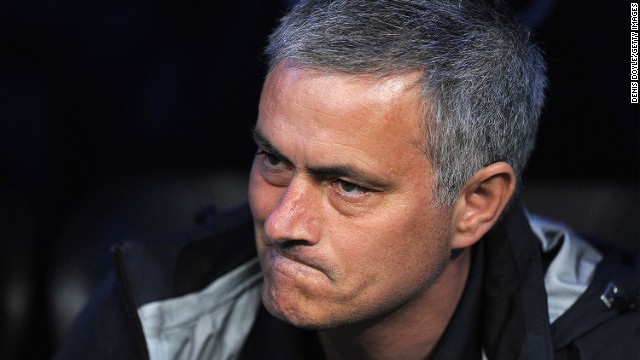
Jose Mourinho will leave Madrid at the end of the season after three years in charge
By his own admission
Mourinho, who won one La Liga crown and a Copa del Rey with Real after
taking charge in 2010, has endured what he has called his "worst season"
in management.
"The club and manager agree that the timing is right to bring the relationship to an end," said Perez.
"On behalf of the board of directors, I would like to thank Jose Mourinho for all his hard work over the last three years."
Mourinho will stay on for
Real's remaining league fixtures, with an away trip to Real Sociedad on
May 26 and a final home game at the Bernabeu on June 1 against Osasuna.
Real will finish second in La Liga this year, trailing champions Barcelona by 12 points after 36 rounds.
The parting of ways comes
three days after Mourinho was sent off as Real lost the Copa del Rey
final 2-1 to Atletico Madrid, a first defeat by their neighbors in 14
years.
Real president Perez
explained that the decision was a "mutual agreement", so paving the way
for Mourinho to make a return to England's Premier League.
"I know in England I am loved," said the Portuguese last month. "I know I am loved by some clubs, especially one."
The 50-year-old has been
heavily linked with a return to former club Chelsea, where he won two
Premier League titles and one FA Cup between 2004 and 2007.
This year's Europa
League champions will be without a coach on June 1, with the contract
for interim manager Rafa Benitez expiring at the end of May.
The decision to part
ways via "mutual agreement" means neither Real nor Mourinho will have to
pay one another millions of dollars in compensation had either of them
broken the terms of their contract.
After winning La Liga last year, Mourinho had signed a new four-year deal with the Merengues.
The compensation package
was believed to be a potential obstacle to his return to Stamford
Bridge, where Chelsea owner Roman Abramovich paid Mourinho and his
coaching staff some $27 million after his contract ended early in 2007.
Paris Saint-Germain coach Carlo Ancelotti, who formerly led Chelsea himself, is rumored to be Mourinho's replacement.
On Monday, Perez denied that any deal has been agreed to replace the former Inter Milan and Porto manager.
"We have no pre-contract
signed with any managerial candidate," he said. "It's something we'll
have to look at in the coming days."
Ancelotti confirmed on
Sunday that he had asked to leave the French champions, while the club's
Qatari owners suggested he already had an agreement in place with Real.
Desperate to be crowned
champions of Europe for a record tenth time, with their last success
dating back to 2002, Real Madrid turned to Mourinho just days after he
lifted the Champions League with Inter Milan, ending a barren 35-year
run for the Italians.
Yet the Portuguese was
beaten in the semifinals of the competition each year with Real, who
were knocked out by Borussia Dortmund last month.
Without a trophy in the
two years prior to his arrival, Mourinho did at least return silverware
to the club - winning the Copa del Rey in his first season in charge.
In 2012, he guided Real
Madrid to their first league crown in four years and amassed a record
tally of 100 points along the way, so eclipsing the previous best held
by great rivals Barcelona.
A new deal soon followed
but matters soured this season as Mourinho clashed with several star
players, notably goalkeeper Iker Casillas -- who was demoted from the
first team in recent months -- Sergio Ramos and Pepe.
During his 176 games in charge, Mourinho has led Madrid to 127 victories - losing just 22 games along the way.
India's palace hotels fit for a king
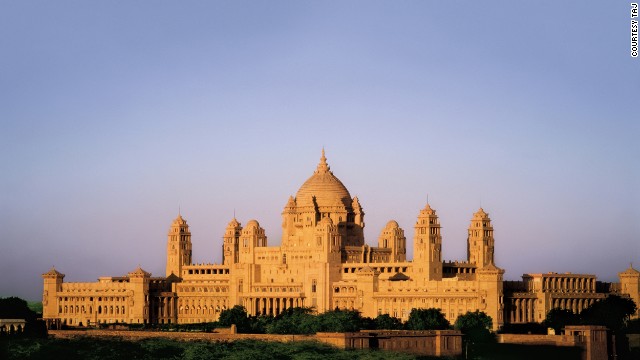 The spectacular sandstone exterior
of the Umaid Bhavan palace in the state of Rajasthan, northwest India.
Still the primary residence of the royal Maharaja of Jodhpur, a third of
the facility was transformed into a hotel in 1972.
The spectacular sandstone exterior
of the Umaid Bhavan palace in the state of Rajasthan, northwest India.
Still the primary residence of the royal Maharaja of Jodhpur, a third of
the facility was transformed into a hotel in 1972.
In the Indian city of
Jodhpur however, one regal residence has parted with ancient convention
and opened its doors to visitors from across the globe.
For the princely sum of $450 a night, travelers can snap up a basic suite in the spectacular Umaid Bhavan.
The elaborate 347-room palace is home to the Maharaja of Jodhpur, and is one of the largest private residences in the world.
After the Indian
government abolished privy purses (a regular allowance the state gave
royal families) in 1972, the Maharaja sought to cut costs and converted a
third of the palace into a luxury hotel.
This section of the building now contains 64 luxury suites operated by hotel giant, the Taj Group.
"It's as if you are
stepping back in time and you can have that same experience but with air
conditioning, with WiFi and your Grohe shower head," said Raymond
Bickson, managing director and CEO of the Taj Group.
Across India, many other
former royal households and stately buildings have opened up in a
similar way, taking advantage of the country's burgeoning tourist trade.
The practice has helped
maintain the architectural splendor of the palaces in question whilst
providing an authentic way for travelers to experience India's rich
cultural heritage -- if they have the money.
English-language manual helps the fight back for Hong Kong kung fu
By Peter Shadbolt, CNN
May 21, 2013 -- Updated 0346 GMT (1146 HKT)

Lam Chun-fai Sifu with his son Oscar display one of the Hung Kuen kung fu stances
But ask Lam Chun-fai Sifu
-- the 73-year-old practitioner of the 300-year-old kung fu style known
as Hung Kuen -- and he will tell you that making the martial art
accessible to foreigners is the only way to save it from extinction.
The son of a student to
Wong Fei Hung, one of the legends of the fighting style and the subject
of countless films, Lam Sifu (sifu is a Cantonese term that means
'master') says the fighting art may be growing fast overseas, but
struggles in the region where it was born.
To counter the decline,
he has co-authored the world's first English-language manual on the
ancient kung fu style that he has taught for 60 years and has been his
family's trademark for more than three generations.
Called Hung Kuen
Fundamentals: Fok Fu Kuen, the manual outlines scores of moves and
stances that were hitherto only taught and transmitted orally.
While there are dozens of
fighting styles in kung fu (the northern styles represented by fast,
high kicks and rapid, fluid movements), Hung Kuen is a southern Chinese
fighting art characterised by strong stances and fast footwork. One
practitioner famously destroyed the bamboo planks in a demonstration
platform simply by shifting his feet in the 'hard stances' of Hung Kuen.
Lam Sifu, meanwhile,
teaches a steady stream of foreigners the ancient fighting art in the
cramped living room of his tiny apartment on the 7th floor of a tenement
block in Hong Kong's North Point.
In terms of Hong Kong
kung fu, it's about as traditional as it gets, right down to the name
'Di Dat Clinic' which translates as 'Hit Fall Clinic'; a name unchanged
from the days when kung fu masters, so used to treating the training
accidents of their students, were the first stop for neighborhood trauma
injuries and broken bones.
Using a spear against his
sword-wielding son Oscar, Lam Sifu is a blur of threshing weapons amid
the armchairs, ornaments and computer printers in his urban home.
"Training in a small
area like this is very good for control," he says in a space so cramped
it looks like two men having a knife fight in a telephone booth. For his
long-standing foreign students -- Hung Kuen teachers from Italy, the
Czech Republic and Germany -- the turn of fighting speed still draws a
gasp of admiration.
"Many students in Italy
like traditional kung fu and especially this style which is the origin
of the martial art," said Massimo Iannaccone, who runs an academy in
Rome but perfects the art in Lam Sifu's living room on trips to Hong
Kong.
Pavel Adamek, who
teaches Hung Kuen in Prague, Czech Republic, says his students are drawn
as much by the Eastern philosophy associated with the martial art as
they are by learning a fighting style.
"It's very popular in
the Czech Republic -- people there are really looking for something more
than fighting arts. They want to train their bodies and their minds --
this style is really very good for that," he said.
While there may be more
dedicated practitioners overseas than in Hong Kong, Lam Sifu's co-author
Hing Chao, who also studies the Hung Kuen style, said that the form
remains a potent cultural symbol in Hong Kong.
"It's rooted in a very
specific Hong Kong identity as well," Hing said. Both he and Lam Sifu
believe the style is so important as a cultural symbol, the government
should recognize it as part of Hong Kong's intangible cultural heritage.
Training in a small area like this is very good for control
Lam Chun-fai Sifu
Lam Chun-fai Sifu
Hing, who has studied
the interaction between the media, entertainment and the martial arts,
says that Hollywood sometimes gives a lopsided view of Chinese martial
arts, focusing on various personalities such as Ip Man, Bruce Lee's
famous teacher, to the exclusion of all other equally famous teachers
and styles.
Despite this, he says its popularization in film sometimes unconsciously transmits positive aspects of kung fu culture.
"Besides the fighting,
one of the reasons that Bruce Lee has been such a global celebrity until
to today is because a lot of messages strike a chord and resonate among
the marginalized," Hing says.
"Why would, for
instance, a Black African community in the U.S. look on Bruce Lee as a
hero? Because embedded in these films are messages of righteousness. Of
someone who is disadvantaged but through dedication to kung fu can
become empowered and through his own empowerment help the rest of the
community.
"This is very positive
and I would say the Bruce Lee path represents one of the best
interactions between film and martial arts -- it's something we don't
often see these days."
While foreigners may be
beating a path to the kung fu clinic's door, local interest in Hong Kong
is only just gaining ground after a long hiatus.
Lam Sifu says modern
distractions like videogames are sapping young people of the ability to
focus on demanding martial art forms like Hung Kuen which can require
learning as many as 300 movements in a single set.
"These days pupils can't stand any hardship. They say practicing is tiring and they give up easily," he says.
Samsung Galaxy S4 named top smartphone by Consumer Reports

Consumer Reports gave top marks to Samsung's Galaxy S4 phone.
The previous list-topper
was the Optimus G, a solid $100 4.7-inch phone from LG that held
Consumer Reports' No. 1 spot for several months. The Optimus G is now
ranked as the No. 2 smartphone, followed by the HTC One, the Samsung
Galaxy S3 and the Apple iPhone 5.
Consumer reports bases
its ratings on a number of extensive tests and rates the devices in
categories including ease of use, display and voice quality, portability
and battery life. The $200 Galaxy S4's weakest scores were in video
quality and portability. Like all the other smartphones on the list, it
also had mediocre scores for voice quality, a sacrifice that seems
common in the smartphone market. The publication also lamented the lack
of one-button phone access.
Consumer Reports
specifically called out the S4's 5-inch, 1080p touch-screen,
multitasking in split view, and a built-in IR feature as some of the
handset's standout features. The abundance of features were seen as
appealing to more advanced users without complicating the phone for more
entry-level users. The publication said the device's camera was "among
the best phone cameras for photo quality."
The Galaxy S4 is an
update to Samsung's wildly popular S3 phone, which was one of the best
selling smartphones of the past year. Samsung was the leader in the
smartphone market in in the first quarter of 2013, according to research
firm IDC, and it looks like its latest offering will help it hang on to
that top spot for the time being.
Last week, Google
announced a new version of the Galaxy S4 that will run a pure form of
the company's Android mobile operating system. That unlocked and
uncluttered phone will cost $649 when it becomes available at the end of
June.
Should tennis be worried about the 'kissing disease'?
Roger Federer played at the
Australian Open in 2008 not knowing he had mono. At the height of his
powers, he surprisingly needed 4.5 hours to beat Janko Tipsarevic in the
third round.
It was a surprise, since
the young American prospect was considered a player with good stamina
and has already earned a reputation for wearing down her opponents, not
vice versa.
After a first-round victory at the French Open, McHale felt particularly exhausted.
"I won 6-4 in the third
set, but I remember saying to my coach that I feel like I've just been
hit by a bus," the 21-year-old recalled.
At first she thought it
was a sinus infection. Then a couple of months later, following the
Olympic tennis event at Wimbledon, McHale picked up a stomach bug and
had to go to hospital. Her ordeal dragged on.
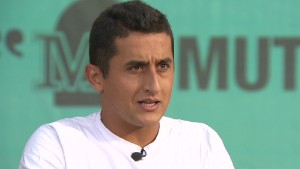 Nadal challenger makes a splash
Nadal challenger makes a splash
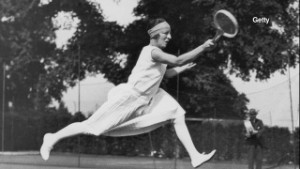 The first diva of women's tennis
The first diva of women's tennis
 Beating the 'French Open curse'
Beating the 'French Open curse'
"I kept going back to the
doctors because I wasn't getting better," McHale said. "I was still
feeling very low on energy and they were like, 'No, you should already
be over the stomach virus.' So then they started doing more tests, and
that's when they found out what it was."
The diagnosis was
mononucleosis, a viral illness that can linger for weeks, months or even
years. It has earned the nickname of the "kissing disease" because it
can get passed from one person to another through saliva. Fortunately
for McHale, her bout was coming to an end.
McHale, though, isn't the
only tennis player in recent years to be afflicted with mono or the
name it's also known by, glandular fever.
Others on the list
Top men's players Roger
Federer, Andy Roddick, Robin Soderling, Mario Ancic and John Isner have
been struck down, while Heather Watson, like McHale a player with
promise, revealed she had mono in April.
Jarmila Gajdosova, another promising player on the women's tour, announced last week on Twitter that she had mono.
Soderling and Ancic
weren't as lucky as the likes of Federer, McHale and Watson, who hopes
to return to action at the French Open, which starts this weekend.
Indeed the severity of cases varies, as does an individual's capacity to
fight off and cope with infections.
Soderling, the French
Open finalist in 2009 and 2010, hasn't played since 2011 and it is
looking increasingly likely that he won't ever come back.
The Swede with the
massive forehand -- who handed Rafael Nadal his only defeat at Roland
Garros -- started to feel unwell in the spring of 2011 and later said it
was a mistake to compete at Wimbledon that year.
Ancic, hailed as a
potential winner at Wimbledon after reaching the semifinals in 2004,
attempted to play through his flu-like symptoms during a Davis Cup
series against Germany in 2007.
He said he felt so dizzy in his singles opener he missed a ball completely, but he still contested the doubles a day later.
He was ready to play the
deciding fifth rubber if needed, although with Germany already
clinching the tie he was replaced by a young Marin Cilic.
 French Open champs on the future
French Open champs on the future
 Sharapova prepares for Roland Garros
Sharapova prepares for Roland Garros
 Tennis Tips: Recovery footwork
Tennis Tips: Recovery footwork
"God saved me," Ancic, known for his work ethic and willingness to play through injuries, said in an interview in 2007.
Ancic re-emerged on the tour but was never the same and a teary-eyed Croatian had to retire two years ago aged 26.
Andy Murray, the current
world No. 2, feared he had mono four years ago, and it's an illness
he's still wary of, telling the Daily Telegraph in March: "You can get
run down and end up missing two or three months of the year because of
an illness.
"Your immune system gets
run down and then you lose weight. It's happened with a lot of guys
with glandular fever the last few years so it's something everyone has
to look into."
Continuous travel, training
Former pro Justin Gimelstob isn't surprised that tennis players are susceptible.
The players have to, at times, switch continents on a weekly basis, and they travel 10-11 months in a year.
Unlike golf, cricket or
Formula One, others sports that require continual global travel, the
players also push themselves to the limit physically.
The career of Gimelstob,
who now commentates and serves as a player representative on the ATP
World Tour's board of directors, was blighted by a back injury.
"I think that's the
thing people don't understand -- the heightened intensity does damage to
your body, immune system, energy levels, on the fitness of your
muscles, ligaments, tendons," Gimelstob said.
"It's just a very tough
sport. I truly believe that Nadal, Murray, (Novak) Djokovic and Federer,
these guys aren't only the best tennis athletes in the world, they are
some of the best athletes in the world.
"There's a whole culture of being tough and strong and pushing through pain and being a warrior.
"But I can tell you
right now at 37 years old walking my dog, my body feels the brunt of
probably doing a lot of things and pushing through barriers I probably
shouldn't have. That's the product of an individual sport."
At first Leslie Findley,
a consultant neurologist in England who has treated marathon runners,
footballers and tennis players with mono, said it was a "myth" that
those involved in tennis are more vulnerable than other athletes.
But he subsequently acknowledged that when factoring in their travel, the severity of the illness can intensify.
"We know people with fatigue illnesses related to the effects of viruses travel badly," he said.
"If you take someone
with a chronic fatigue syndrome and stick them on an airplane at
(London's) Heathrow to the United States they'll do an eight-hour
flight. That can have a devastating effect on them for days afterwards."
Preventing mono can be
difficult, but Findley said it's important that players heed warnings.
If they suddenly develop a cold, fever, sore throat or stomach issues,
it's vital to rest instead of continuing to train and play matches.
Stopping not easy
As Gimelstob pointed out
and Findley knows through his own experience in working with sportsmen
and women, that isn't always easy.
"When you and I have the flu, we go to bed and within a week or two we'd be back to normal," Findley said.
"Why these people get
symptoms that go on for weeks, months and years is usually because --
and I'm now generalizing -- they don't stop when they have the first
symptoms and tend to push through, and they're under stress."
Diagnosing mono isn't simple, either, said Findley.
He said there is a lack
of specialists and that doing a battery of tests at the outset may not
be efficient. He will usually spend nearly two hours talking to patients
in a first consultation before making a clinical diagnosis.
"Then there are a
limited number of blood tests that need to be done to make sure there is
nothing else contributing to it," Findley said.
The women's tennis tour
said in an email that player health and well being was a "priority." But
the age of many of its pros is another reason why tennis players would
appear to be at risk.
"Mononucleosis most
commonly occurs in people between the ages of 15 and 24, which is our
athlete population," said Kathleen Stroia, senior vice president, sport
sciences and medicine & transitions, with the WTA.
The men's tour said in an email that mono "has not been of unusual concern for the players or the ATP Medical Services."
 The story behind Sharapova's success
The story behind Sharapova's success
 Radwanska: Playing Serena was tough
Radwanska: Playing Serena was tough
 Ivan Lendl: There are plenty of champs
Ivan Lendl: There are plenty of champs
"Professional athletes
are not immune to illnesses which affect the general public in general,"
said Gary Windler, medical advisor to the ATP World Tour.
"While we are concerned
about and take all injuries and illness seriously, and although some
high profile players have suffered from glandular fever in recent years,
the incidence of this particular illness amongst our players in general
has not been unusually high."
McHale didn't think her tour needed to do more to help players.
"I think we're probably more susceptible to getting it because our bodies are more run down from traveling so much," she said.
"Also sometimes I take a
water bottle -- they all look the same -- to the court and all of a
sudden I'm like, 'This wasn't my water bottle.' Sometimes it gets
transferred like that.
"I know a lot of my
friends have gotten it. They're not athletes. For them it wasn't a big
issue. It's amplified when you're an athlete."
Tough comeback for McHale
Her road back hasn't been smooth.
McHale, like others
before her, didn't stop playing for a while. But after losing five
straight matches, she finally decided to sit out the remainder of 2012
and not contest the European indoor swing. The losing streak rose to
eight by the time this January's Australian Open ended.
As high as No. 24 in the world last summer, her health issues largely contributed to her ranking sliding to 55th.
She has resumed training
fully and played for nearly three hours against 2012 French Open
finalist Sara Errani in Rome on Wednesday but knows she must be careful.
"They did tell me
there's a chance I could get a relapse, so I have to take it easy if I'm
feeling extremely exhausted," she said. "But I think I'm past that
point. I don't feel any side effects of what I had. I feel like I'm
fully over it now. I was lucky my case wasn't extremely bad like some
others."
Opinion: Nigerians ask, are we at war?
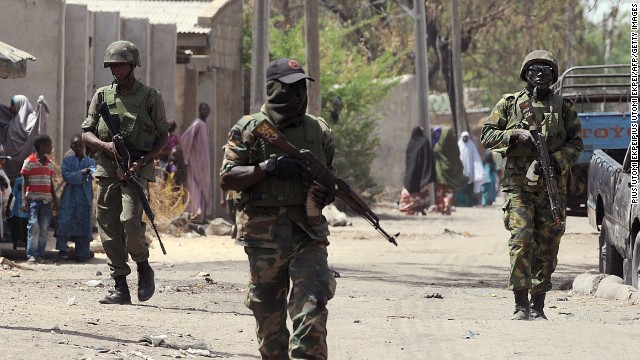
Nigerian troops patrol the streets of the remote northeast town of Baga, in Borno State, on April 30.
Suicide bombing, towns
and villages getting blown up, allegations of extra-judicial killings by
the police and the military, kidnappings, terrorist attacks on
government establishments -- total confusion and a lack of solutions to
the violence is no longer just news, but a terrifying daily reality
show.
In the current wave of
violence, especially in the northern and middle belt of the country,
which has culminated in President Goodluck Jonathan declaring a state of
emergency in the three states of Adamawa, Borno and Yobe, one is at a
loss as to where the country is headed in its near future.
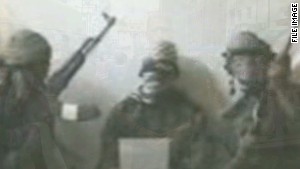 2012: Who are Boko Haram?
2012: Who are Boko Haram?
 Obasanjo: Boko Haram undermine security
Obasanjo: Boko Haram undermine security
 Nigerian president: Boko Haram 'threat'
Nigerian president: Boko Haram 'threat'
What has happened in
Borno, a state in the northern part of Nigeria, in the past weeks is
like full-scale war. A local official said recent attacks there, in the
border town of Baga, left more than 185 inhabitants dead in unclear
circumstances involving the military Joint Task Force (JTF), the
peace-keeping government outfit that has been effectively inefficient in
all the troubled zones. The army, however, said no more than 36 people
were killed.
The burning embers of the
Baga massacre had hardly cooled off when another attack was carried out
in Bama, another town in the same state. According to the army, 55
people were killed by Boko Haram; casualties including women and
children were burnt alive.
Following these deaths
came yet another wanton killing of policemen and soldiers in another
state. The dead, as usual, are a mixture of innocent civilians, military
personnel, policemen and members of Boko Haram, the Islamic militant
group that has been carrying out attacks since 2009.
The total break down of
law and order and daily carnage made the governor of Borno, Alhaji
Kashim Shettima, put the blame squarely on the doorsteps of his fellow
politicians and the Nigerian government as the primary cause of the
country's state of insecurity.
According to the
governor, "Underneath the mayhem of Boko Haram lies the underlying cause
which is extreme poverty and destitution ... until we address some of
these issues the future is very bleak for all of us as the current
crisis is just an appetizer of things to come. Very soon the youth of
this country will be chasing us away."
The governor also gave
his view of the current mindset of Nigeria's political ruling class:
"The most important thing in Nigeria is about the last election and the
next election, the only thing that is agitating our minds is how we can
perpetuate ourselves in power. How much we can steal, how many mansions
we can buy in Florida, Dubai and London, this is what agitates the minds
of the elites of this country."
To hear this kind of
finger-pointing and chilling words from one of those the rest of the
country expects to resolve the conflict and bloodletting is quite
enervating.
A previously proposed
panacea to the madness was the proffering of amnesty to Boko Haram
members by the federal government, which it has so far refused.
The whole amnesty idea
to many observers bordered on the line of insanity and inanity. Two
things -- the amnesty program that was first introduced to curb violence
and pacify militants in the Niger Delta by the late President Umaru
Yar'Adua and continued by Jonathan, cannot be said to be successful, as
insurgency is still very much a clear and present danger in the Niger
Delta. Secondly, it looks like crime pays in Nigeria when criminals and
murderers are getting rewarded in the name of "amnesty" every time they
put a gun or bomb to the government and people's temples.
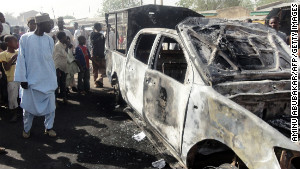 Boko Haram blamed for attacks in Nigeria
Boko Haram blamed for attacks in Nigeria
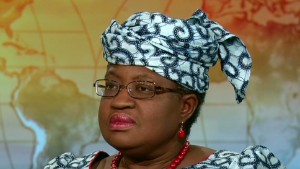 Spreading the wealth in Nigeria
Spreading the wealth in Nigeria
Wealthy Nigerians and
multinational expatriates have become prisoners in a supposedly free
country, constantly moving with heavily armed guards. For most, this has
not proven effective as some of their armed guards have been outgunned
by terrorists and criminals who mean business.
Politicians are
sometimes the worse off, and one cannot help but reason that the poverty
planted by the rich and the ruling class over decades of misrule has
yielded thorns in the flesh of our country.
Despite the declared state of emergency (which has received a mixed reception), people are losing hope faster than a nailed tire.
The insecurity is
spreading to other parts of the country. Lagos is now taking on a new
look of security consciousness. Many churches in the city have fully
armed policemen holding AK47s guarding entrances during Sunday services.
And it is no longer odd to walk into a cafe or restaurant and find
armed policemen guarding diners, with guns resting among cutlery.
The government seems to have keeled over and resorted to a full-blown military offensive,
both land and air, against Boko Haram and its allies. It is too early
to determine if this latest solution will abate the madness but it is
horrifying for people to live with this kind of killing and uncertainty
every day.
When we now appear in
foreign news segments we are right there with Syria, Afghanistan, Iraq
... places that are in full blown war and used to seem so far away. And
the question trembling in most people's lips now is -- are we also at
war in Nigeria?
'Are you in
Nigeria? Have you been affected by the violence? Do you think the
country is at war and, if so, how can it be stopped? Add your thoughts
in the comments below.
51 killed in mammoth Oklahoma tornado; 40 more bodies expected
Teachers lead children away from
Briarwood Elementary School after a massive tornado destroyed the
building in Oklahoma City on Monday, May 20. The death toll continues to
climb as rescuers search for survivors. It was part of a tornado
outbreak that began in the Midwest and Plains on Sunday, May 19. View more photos of the aftermath in the region.
But as they searched
through the night and Tuesday morning, the sobering death toll continued
to climb in this city far too familiar with nature's wrath.
The vicious tornado that
ripped across central Oklahoma on Monday killed at least 51 people --
with about 40 more bodies expected to arrive at the Oklahoma state
medical examiner's office, Amy Elliott of the coroner's office said.
Roughly half of the expected bodies are children.
The official death toll will gradually rise from 51 as each of the bodies are processed, Elliott said.
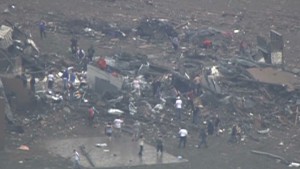 Tornado leaves path of destruction
Tornado leaves path of destruction
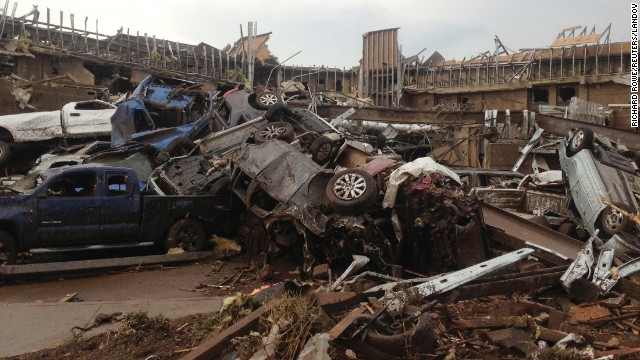 Photos: Tornadoes wreak havoc in Midwest
Photos: Tornadoes wreak havoc in Midwest
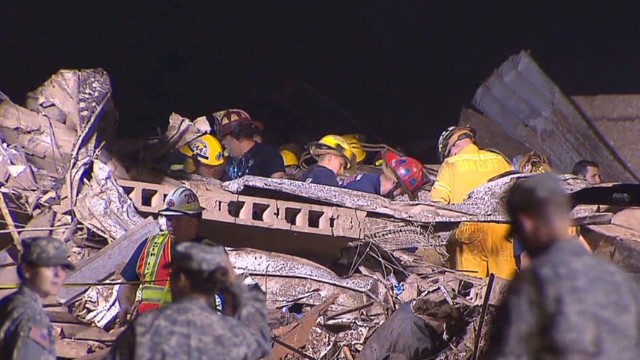 Rescue efforts continue at school
Rescue efforts continue at school
 Tornado survivor: I just want to cry
Tornado survivor: I just want to cry
Already, at least 20 of
those killed were children, including seven from Plaza Towers Elementary
School in Moore -- the site of a frantic search Tuesday morning.
The school was in the
direct path of the storm's fury. About 75 students and staff members
hunkered down in Plaza Towers when the tornado hit, CNN affiliate KFOR
reported.
At one point, an
estimated 24 children were missing from the school, but some later
turned up at nearby churches. It's unclear how many may still be trapped
in the wreckage, and how many are dead or alive.
A father of a third-grader still missing sat quietly on a stool outside. Tears cascaded from his face as he waited for any news.
Even parents of survivors couldn't wrap their minds around the tragedy.
"I'm speechless. How did
this happen? Why did this happen?" Norma Bautista asked. "How do we
explain this to the kids? ... In an instant, everything's gone."
Across town, Moore Medical Center also fell victim to the tornado.
"Our hospital has been
devastated," Mayor Glenn Lewis said. "We had a two-story hospital, now
we have a one. And it's not occupiable."
So 145 people were rushed to three other area hospitals.
That number includes 45
children taken to the children's hospital at Oklahoma University Medical
Center, Dr. Roxie Albrecht said. Injuries ranged from minor to severe,
including impalement and crushing injuries.
Not the first time
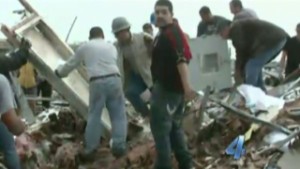 Rescuers use hands to dig through rubble
Rescuers use hands to dig through rubble
 Storm witness: 'I'm blessed to be alive'
Storm witness: 'I'm blessed to be alive'
 Toby Keith: Hometown storm 'devastating'
Toby Keith: Hometown storm 'devastating'
 Nye: It's going to happen again
Nye: It's going to happen again
Even for a city toughened by massive tornadoes, Moore has never seen this kind of devastation.
The suburb recovered
from a fierce twister in 1999 that killed six people there and dozens in
the area. When that tornado struck, it had the strongest wind speed in
history, Oklahoma Lt. Gov. Tom Lamb said.
Another tornado ripped through Moore in 2003, Lamb said.
This time, the
2-mile-wide twister stayed on the ground for a full 40 minutes, carving a
22-mile path where thousands of residents live.
The twister first touched down in Newcastle, Oklahoma, before ripping into neighboring Moore.
An early estimate rated
the tornado as an EF4, meaning it had winds between 166 and 200 mph,
according to the National Weather Service.
The death toll has far surpassed anything the city has seen from a tornado -- and is expected to climb.
After the ear-shattering
howl subsided, survivors along the miles of destruction emerged from
shelters to see an apocalyptic vision. Buildings were and homes were
shredded to pieces. Remnants of cars twisted and piled on each other.
What used to be a parking lot now looked like a junk yard.
"People are wandering
around like zombies," KFOR reporter Scott Hines said. "It's like they're
not realizing how to process what had just happened."
Hiding in freezers
Hines said rescuers found a 7-month-old baby and its mother hiding in a walk-in freezer. But they didn't survive.
At the devastated hospital in Moore, some doctors had to jump in a freezer to survive, Lamb said.
Lando Hite, shirtless
and spattered in mud, described how the storm pummeled the Orr Family
Farm in Moore, which had about 80 horses.
"It was just like the movie 'Twister,'" he told KFOR. "There were horses and stuff flying around everywhere."
More trouble brewing
But the storm system that spawned Monday's tornado and several other twisters Sunday isn't over yet.
Northeast Texas,
including Dallas, and southwest Arkansas are under the gun for severe
weather Tuesday. Those areas could see large hail, damaging winds and
possibly tornadoes.
A broader swath of the United States, from Texas to Indiana and up to Michigan, could see severe thunderstorms.
"We could have a round 3," Cabrera aid. "Hopefully, it won't be as bad."
Still digging
Plaza Towers Elementary
School was one of countless buildings crushed by the tornado. The
twister sucked up debris and swirled it several miles into the sky.
"The structures that
were just demolished were picked up by the twister here and just jetted
up into the atmosphere 20,000 feet," Cabrera said.
James Dickens is not a
firefighter or medic. He's actually a gas-and-oil pipeline worker. But
that didn't stop him from grabbing a hard hat and joining other rescuers
at the school.
"I felt it was my duty to come help," Dickens said Tuesday after a long night of searching.
"As a father, it's
humbling. It's heartbreaking to know that we've still got kids over
there that's possibly alive, but we don't know."
Welcome to Naija Gist: Car bombings hit Russia's Dagestan
Welcome to Naija Gist: Car bombings hit Russia's Dagestan: Two blasts 15 minutes apart claim at least four lives near justice ministry offices in provincial capital Makhachkala. ...
Welcome to Naija Gist: China and India pledge to improve ties
Welcome to Naija Gist: China and India pledge to improve ties: Leaders of both countries will study ways to ease border tensions and boost bilateral trade after meeting in New Delhi. ...
Car bombings hit Russia's Dagestan
Two blasts 15 minutes apart claim at least four lives near justice ministry offices in provincial capital Makhachkala. | ||

Most of the wounded were caught by the second of Monday's two explosions in Makhachkala [AFP]
|
||
|
At least three people have been killed and 12 more
injured in back-to-back car bombings in the semi-autonomous Russian
republic of Dagestan, Interfax news agency reports citing authorities. The first bomb detonated on Monday in front of the Justice Ministry in the regional capital of Makhachkala. As police descended upon the scene, a second car bomb was detonated by remote control, authorities said. Most of the wounded and the dead were caught by the second explosion, the investigators said. Police agencies gave differing death tolls, with the number ranging from three to eight. About 30 people were believed injured. Images transmitted from the attack site depicted heavy damage. Car bombs, suicide bombings and firefights are common in Dagestan, at the centre of an insurgency rooted in two post-Soviet wars against separatist rebels in neighbouring Chechnya. Conflicting figures Investigators initially said eight people were killed on Monday by the successive blasts, but Russian law enforcement officials later revised the figure down. Twisted wreckage of a car could be seen near the building, which was cordoned off by police. The main suspect in the Boston Marathon bombings in the US, Tamerlan Tsarnaev, lived in Dagestan with his family about a decade ago and visited the region last year.
Russian President Vladimir Putin has ordered law enforcement authorities to ensure fighters do not attack the 2014 Winter Olympics next February in the Black Sea resort city of Sochi, which is close to the North Caucasus. Fighters in the North Caucasus have often sought to increase casualties by setting off an initial blast to attract law enforcement officers and then detonating a second bomb. Dagestan, an ethnically mixed, mostly Muslim region between Chechnya and the Caspian Sea, has become the most violent province in the North Caucasus, where armed groups say they are fighting to carve out an Islamic state out of southern Russia. At least 405 people were killed in Dagestan in violence linked to the insurgency last year, according to the Caucasian Knot website, which tracks developments in the region. Putin launched the second war in Chechnya as prime minister in 1999 and likes to take credit for preventing the region from splitting from Russia. But his 13 years in power have been marred by deadly attacks claimed by or blamed on the fighters. |
China and India pledge to improve ties
Subscribe to:
Comments (Atom)


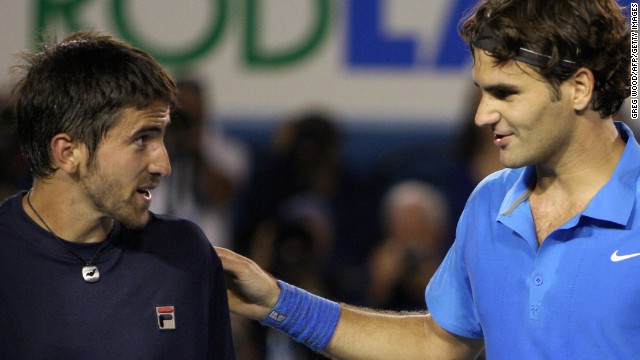

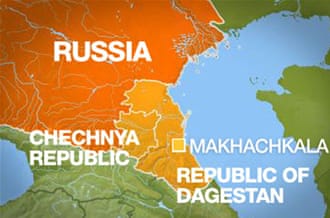
 India and China will study new ways to ease tensions
on their ill-defined border after an army stand-off in the Himalayas,
Chinese premier Li Keqiang has said during his first official foreign
trip.
India and China will study new ways to ease tensions
on their ill-defined border after an army stand-off in the Himalayas,
Chinese premier Li Keqiang has said during his first official foreign
trip.